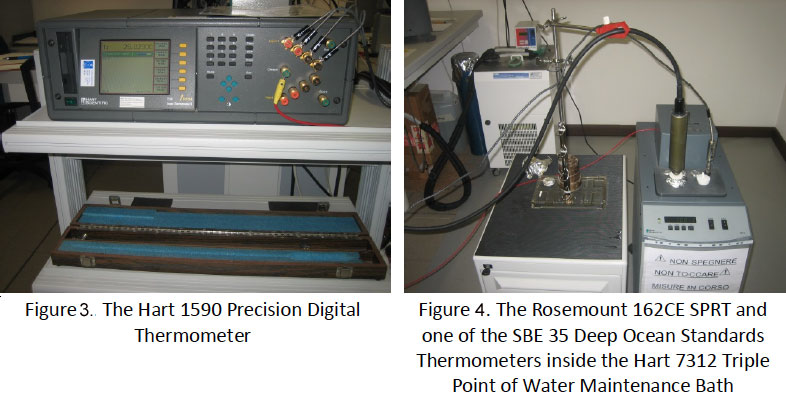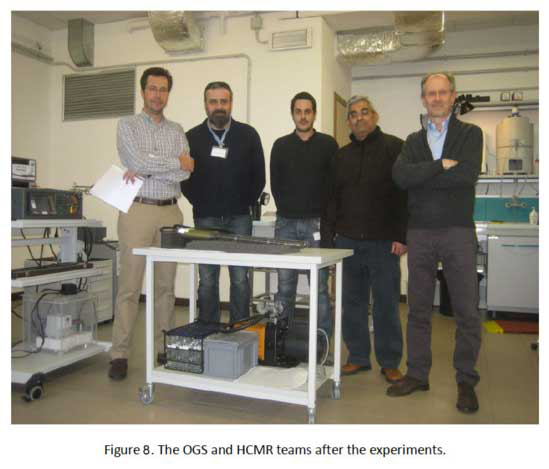February 28th to March 1st, 2013: JERICO TNA “Reference Temperature Calibration (RTC) experiment”
The fourth JERICO TNA experiment took place between the 28th of February and the 1st of March 2013 at the OGS-Oceanographic Calibration Centre (OGS-CTO), the facility for oceanographic testing and calibration of the Department of Oceanography of the OGS (Istituto Nazionale di Oceanografia e di Geofisica Sperimentale), located in Trieste, Italy. The experiment proposal was submitted by HCMR at the First TNA call of JERICO.
The purpose of the experiment was to acquire expertise, receive guidance, and gain “handson” experience in applying the procedures and Best Practice conventions for the calibration of oceanographic temperature sensors using primary reference standards. The long-term goal is for HCMR to be able to perform such calibrations on its own premises. This is essential in order to ensure the quality of the data collected by the POSEIDON network (http://poseidon.hcmr.gr) and field surveys performed by HCMR.
 During the last decade HCMR set up the integrated project POSEIDON, a real-time monitoring and forecasting system for the marine environmental conditions in the Aegean Sea. The monitoring network consists of 11 Seawatch oceanographic buoys, equipped with several sensors deployed at multiple depths, and 9 Smart-wave buoys with the capability of online data transmission to the operational centre of HCMR every 3h through the Inmarsat- C satellite or a GSM mobile telephone communication system. The enhanced forecasting component of the system consists of an atmospheric model, an offshore wave model, a general circulation ocean model, a surface pollutant dispersion model and a shallow water wave model.
During the last decade HCMR set up the integrated project POSEIDON, a real-time monitoring and forecasting system for the marine environmental conditions in the Aegean Sea. The monitoring network consists of 11 Seawatch oceanographic buoys, equipped with several sensors deployed at multiple depths, and 9 Smart-wave buoys with the capability of online data transmission to the operational centre of HCMR every 3h through the Inmarsat- C satellite or a GSM mobile telephone communication system. The enhanced forecasting component of the system consists of an atmospheric model, an offshore wave model, a general circulation ocean model, a surface pollutant dispersion model and a shallow water wave model.
HCMR has established an in-house calibration laboratory for the evaluation and calibration of its oceanographic sensors and instruments. For the calibration of the temperature sensors, two standard platinum thermometer(s) manufactured by Seabird Electronics, Inc. and a large temperature-controlled bath are employed. However, for proper calibration, the reference standard platinum thermometer(s) should be maintained within specifications by linearization, slope and offset adjustments using primary temperature standards (ITS-90 fixed points). The calibration of oceanographic temperature sensors using primary temperature standards requires expertise, and is a delicate and labour-intensive process, often associated with heavy costs for the operators. The HCMR calibration lab does not currently employ this calibration procedure.
 The OGS-Oceanographic Calibration Centre (OGS-CTO) is the facility for oceanographic testing and calibration of the Department of Oceanography of the OGS (Istituto Nazionale di Oceanografia e di Geofisica Sperimentale), located in Trieste, Italy. It provides the scientific and technical infrastructure necessary for high-quality observations of the marine environment using procedures that repeatedly meet recognized international standards of excellence. A critical element of the services offered is the ability to calibrate and maintain sea-going instrumentation efficiently. The facility is run applying relevant international guidelines and protocols as much as practically possible in order to assure conformity or, at least, compatibility, with the regulatory standards governing this kind of activity worldwide.
The OGS-Oceanographic Calibration Centre (OGS-CTO) is the facility for oceanographic testing and calibration of the Department of Oceanography of the OGS (Istituto Nazionale di Oceanografia e di Geofisica Sperimentale), located in Trieste, Italy. It provides the scientific and technical infrastructure necessary for high-quality observations of the marine environment using procedures that repeatedly meet recognized international standards of excellence. A critical element of the services offered is the ability to calibrate and maintain sea-going instrumentation efficiently. The facility is run applying relevant international guidelines and protocols as much as practically possible in order to assure conformity or, at least, compatibility, with the regulatory standards governing this kind of activity worldwide.
At present, the OGS-CTO provides high-calibre temperature and conductivity calibrations, able to meet the demanding oceanographic measurement specifications for these parameters. It is also capable of performing functional tests, evaluations and validations of instrumentation used for measuring other commonly monitored parameters like turbidity, pH, etc.
The sensors under calibration were two SBE35 Deep Ocean Standards Thermometers (serial numbers 58 and 59) manufactured by Seabird Electronics, Inc. that were purchased by HCMR in 2007. One of them, the one bearing serial number (s/n) 59, had never been used in the field while the other has been employed in HCMR’s evaluation/calibration experiments.

For the linearization procedure, the two sensors were placed in a Hart 7052 Seawater Calibration Bath together with a Metal-sheath SPRT Rosemount model 162 CE for taking reference temperature readings . Seven calibration set-points (28 °C to 2 °C) were chosen, and at each set-point, the bath temperature was logged for 10 minutes. The averaged data of the sensors at the different set-points and the corresponding temperature residuals with respect to the relevant reference temperatures are presented in Figure 5.

The data showed that neither of the two sensors required any changes in their linearization coefficients at the present time.
Subsequently, the slope and offset terms of the two sensors were evaluated one at a time at the Triple Point of Water (TPW) and the Melting Point of Gallium (MPGa) using appropriate, certified ITS-90 fixed point cells.

The results indicated that the slope and the offset of one of the the units, specifically, s/n 58 had slightly changed since its last calibration (Table 1), and the experimental data was used to recompute a new slope and offset.

The performances of this unit with its “as received” and new slope and offset settings have been compared using the data from the linearization testing in Figure 7.

Both of the calibrated SBE 35 units will be used as reference sensors for temperature in the calibration laboratory of the HCMR at its facilities in Thalassokosmos in Crete (Greece).

by Manolis Ntoumas (1), Rajesh Nair(2) , Nevio Medeot(2) , Fotis Pantazoglou(1) ,George Petihakis (1)
- Hellenic Center for Marine Research, ,HCMR,Heraklion, Crete, Greece.
- Istituto Nazionale di Oceanografia e di Geofisica Sperimentale,OGS,Trieste,Italy
